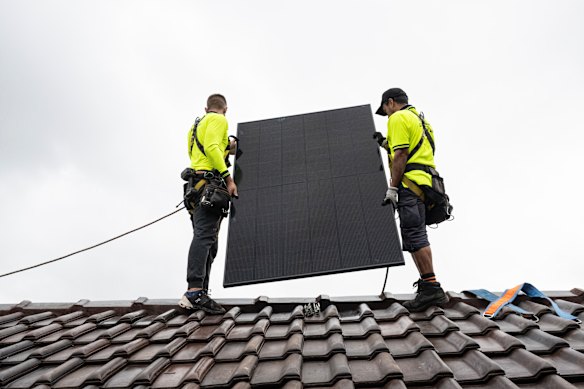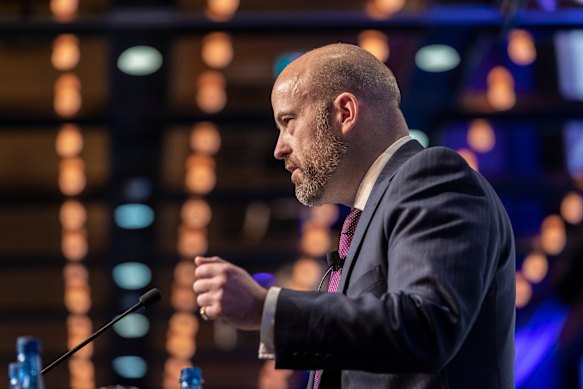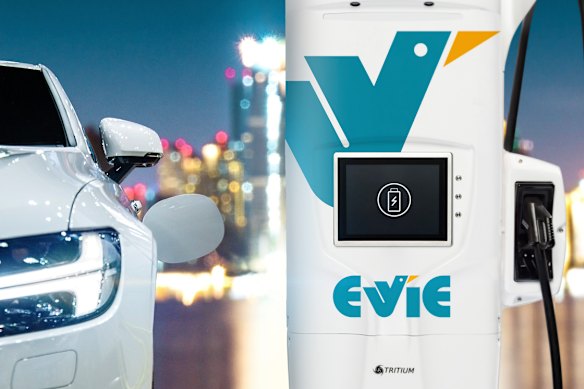By Nick Toscano
Millions of Australians face being left behind in the race to greener energy, one of the nation’s largest power distributors has warned, as renters miss out on huge savings from solar panels while homes without off-street parking cannot install electric vehicle chargers.
From this year, home-owners with solar panels stand to benefit from even bigger electricity bill cuts following the introduction of federal government rebates wiping thousands of dollars off the cost of installing batteries that can soak up their excess energy.

More than 4 million Australians are producing their own electricity from the sun via their rooftop solar.Credit: Louise Kennerley.
Increasing home battery uptake has many advantages: it will enable Australia to harness more of its world-leading per-person solar panel uptake to use after sunset, drive down greenhouse gas emissions and smooth out volatile price swings across the market.
But the household clean energy boom may create winners and losers, warns Ausgrid, the largest power distribution company on Australia’s eastern seaboard. The company points to renters and lower-income Australians who are unable to make the switch and are forced to stay on increasingly expensive fossil fuel-based energy supplies.
“The problem we see is that if you don’t own your own home, or have the financial wherewithal, you are faced with the full system cost of the transition,” said Rob Amphlett Lewis, Ausgrid’s group executive of distributed services.
“What we are in danger of is a two-speed transition that works for the ‘haves’ and is paid for by the ‘have-nots’.”
Ausgrid and other Australian distribution network service providers are seeking to expand their reach beyond building and maintaining the network’s poles and wires and into other future-facing functions where they believe they are well placed to deliver more efficient outcomes for consumers.
Their push, however, has opened a major new rift in the industry between network operators and a wide range of other electricity market participants, which are urging regulators against any waiver from “ring-fencing” rules designed to prevent monopolies from encroaching on competitive markets, and argue it could drive up costs.
Among Ausgrid’s trials are programs to operate small- to medium-sized batteries and so-called “community power networks”, through which it could install and orchestrate solar panels and batteries in certain areas to shift daytime solar energy to the evening peaks, smoothing out grid demand.

Ausgrid’s Rob Amphlett Lewis: “We are in danger of a two-speed transition.” Credit: Louie Douvis
Distribution companies including Victoria’s CitiPower, Powercor and United Energy are seeking regulatory changes, allowing them to install and maintain kerbside electric vehicle chargers on their power poles. Ausgrid has been allowed to run a pilot program through a subsidiary to install 1000 kerbside chargers in NSW.
Both the community power and EV-charging proposals have run into strong opposition from across the industry, including from energy retailers, charge-point operators and electric vehicle businesses.
The National Electrical and Communications Association, which represents electrical contractors, has slammed distributors’ kerbside charging plan as an “unprecedented power grab” that could drive up bills.
AGL, one of the largest Australian power generators and retailers, said allowing distributors to control the charging infrastructure rollout could undermine incentives for competitive providers, leading to a less efficient and more expensive delivery of those assets.
“As a general economic principle, monopoly service providers are incentivised to over-price and under-service customers,” AGL said.
Electric vehicle-charging company Evie Networks raised concerns that distributors would recover costs involved from their broader regulated networks, including from non-EV drivers. “This is the wrong policy solution for the right problem,” it said.
Ausgrid has said its community power networks proposal would recover costs from the benefits it generated, and it has assured customers that the company would carry any risk around cost blow-outs in the trial phase.
Its kerbside charging plan, meanwhile, could help overcome the market failure of a lack of public EV chargers that was holding many motorists back from switching to electric vehicles, which cost less to run than petrol and diesel-powered vehicles, Amphlett Lewis said.
“There are real obstacles for people without off-street parking to feel comfortable about making their next vehicle purchase an EV, and that’s because we don’t have the sort of numbers of EV chargers in the community,” he said.

Evie Networks raised concerns that distributors would recover costs involved from their broader regulated networks, including from non-EV drivers.Credit: EV Connect
Amphlett Lewis attributes some industry pushback to concerns that distributors were seeking to expand into areas that could imperil other companies’ business models.
“We are putting our hands up to say: ‘This is what we can do to support a quicker, cheaper and more equitable transition for customers’. Tomorrow’s problems aren’t going to be solved with yesterday’s solutions.”
The Business Briefing newsletter delivers major stories, exclusive coverage and expert opinion. Sign up to get it every weekday morning.